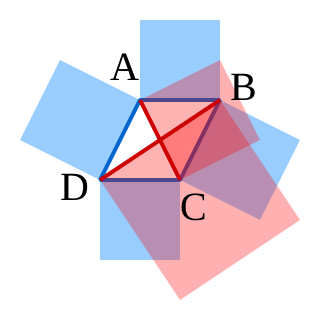The polarization identities reverse this relationship, recovering the inner product from the norm. Every inner product satisfies:
Complex vector spaces
For vector spaces over the complex numbers, the above formulas are not quite correct because they do not describe the imaginary part of the (complex) inner product. However, an analogous expression does ensure that both real and imaginary parts are retained. The complex part of the inner product depends on whether it is antilinear in the first or the second argument. The notation  which is commonly used in physics will be assumed to be antilinear in the first argument while
which is commonly used in physics will be assumed to be antilinear in the first argument while  which is commonly used in mathematics, will be assumed to be antilinear its the second argument. They are related by the formula:
which is commonly used in mathematics, will be assumed to be antilinear its the second argument. They are related by the formula:

The real part of any inner product (no matter which argument is antilinear and no matter if it is real or complex) is a symmetric bilinear map that for any  is always equal to: [proof 1]
is always equal to: [proof 1]

It is always a symmetric map, meaning that [proof 1]

and it also satisfies: [proof 1]

Thus  which in plain English says that to move a factor of
which in plain English says that to move a factor of  to the other argument, introduce a negative sign.
to the other argument, introduce a negative sign.
Proof of properties of  |
|---|
Let  Then  implies implies  and  Moreover,  which proves that  From  it follows that it follows that  and and  so that so that  which proves that   |
Unlike its real part, the imaginary part of a complex inner product depends on which argument is antilinear.
Antilinear in first argument
The polarization identities for the inner product  which is antilinear in the first argument, are
which is antilinear in the first argument, are

where  The second to last equality is similar to the formula expressing a linear functional
The second to last equality is similar to the formula expressing a linear functional  in terms of its real part:
in terms of its real part: 
Antilinear in second argument
The polarization identities for the inner product  which is antilinear in the second argument, follows from that of
which is antilinear in the second argument, follows from that of  by the relationship:
by the relationship:  So for any
So for any 

This expression can be phrased symmetrically as: [5]

Summary of both cases
Thus if  denotes the real and imaginary parts of some inner product's value at the point
denotes the real and imaginary parts of some inner product's value at the point  of its domain, then its imaginary part will be:
of its domain, then its imaginary part will be:

where the scalar  is always located in the same argument that the inner product is antilinear in.
is always located in the same argument that the inner product is antilinear in.
Using  the above formula for the imaginary part becomes:
the above formula for the imaginary part becomes:






























































































































